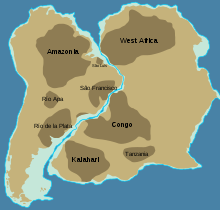Tanzania Craton

The Tanzania Craton is an old and stable part of the continental lithosphere in central Tanzania. Some of the rocks are over 3 billion years old.[1]
Setting
The Tanzania Craton forms the highest part of the East African Plateau.[2] The craton is surrounded by Proterozoic mobile belts of various ages and grades of metamorphism. These include the Ubendian, Usagaran, Karagwe-Ankolean and Bukoban systems. The Mozambique Belt lies to the east.[3] The craton divides the east and west branches of the East African Rift.[2] The southern end of the
Composition
The craton is a composite of several different terranes of Archaean metasediments. The Dodoman is the oldest, and others include the Nyanzian and Kavirondian. Some of the greenstone belts are more than 3 billion years old. They were intruded by granites and migmatized in different events that date back to 2.9, 2.7, 2.4 and 1.85 billion years ago.[1] The
References
- ^ a b c Dawson 2008, p. 9.
- ^ a b Dawson 2008, p. 2.
- ^ a b Geological Framework.
- S2CID 53640435.
- S2CID 37882729. Retrieved 4 August 2017.
- ^ "The Strangest Volcanoes In The World – A Non-Official List". 28 March 2017. Retrieved 4 August 2017.
- ^ van Straaten 2009, p. 280.
Sources
- Dawson, John Barry (2008). The Gregory rift valley and Neogene-recent volcanoes of northern Tanzania. Geological Society. ISBN 978-1-86239-267-0.
- "GEOLOGICAL FRAMEWORK AND REGIONAL METALLOGENY OF TANZANIA" (PDF). Kilimanjaro Mining Company. Retrieved 2011-12-28.
- van Straaten, Peter (2009). "Tanzania" (PDF). Rocks for Crops. University of Guelph.
